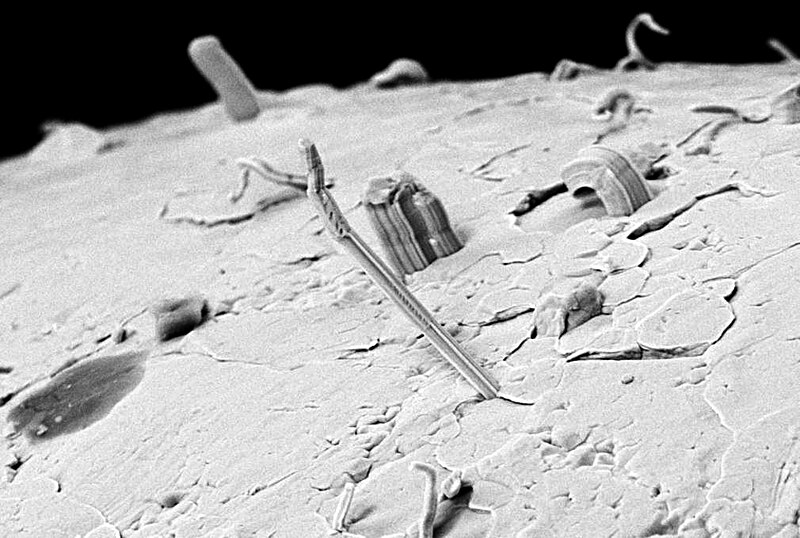File:Tin whisker ESA385984.jpg

原始文件 (1,010 × 679像素,文件大小:264 KB,MIME类型:image/jpeg)
摘要
| 描述Tin whisker ESA385984.jpg |
English: This may resemble an alien landscape, but it is actually a microscopic view of tin used to solder electronic components. The long shard rising from the surface is a ‘tin whisker’ – a spontaneous outgrowth representing a clear and present danger to space missions.
The phenomenon was first identified within terrestrial electronics, but these whiskers are known to grow rapidly out of pure tin in the weightlessness, vacuum and temperature extremes of space. Typically, these crystalline filaments are just a few thousands of a millimetre thick, though may extend more than a thousand times further in length. They are electrically conductive and so can threaten catastrophic short circuits: the US Galaxy IV telecommunications satellite was lost due to this issue in 1998. The traditional method of preventing tin whiskers was to add lead – but lead is toxic, so its use in solder has been phased out through the EU’s Reduction of Hazardous Substances directive. ESA and European space industry have been granted a waiver to continue using tin–lead alloy for solder, but not an indefinite one. “We’ve been researching alternative methods to arrest the growth of tin whiskers,” explains ESA materials engineer Jussi Hokka. “We’ve investigated a technique called atomic layer deposition, widely used in the semiconductor industry to lay down a metal oxide film just a few nanometres deep. “Over a time period of up to a year, this application has led to a significant reduction in the number of tin whiskers, although we don’t yet know if this is due to the surface barrier laid down or some factor of the overall process.” ESA worked with a consortium led by Finnish specialist Picosun, supported by Finnish packaging specialist Poltronic Ltd and Loughborough University in the UK. Follow-up research is now underway. Success will undoubtedly have wider applications: tin whiskers are also re-emerging as a problem of terrestrial electronics now that pure tin solder is in widespread use. ESA’sTommaso Ghidinicomments: “Tin whiskers remain in many respects a mysterious metallurgical phenomenon. But if this technique proves to be successful, we could safely use pure tin as a green option, foregoing carcinogenic lead – not only for space but also for automotive, aeronautics and large other industrial domains, while guaranteeing equivalent engineering performance.” |
| 日期 | |
| 来源 | http://www.esa.int/spaceinimages/Images/2017/11/Tin_whisker |
| 作者 | European Space Agency |
| 授权 (二次使用本文件) |
ESA,CC BY-SA 3.0 IGO |
| Title InfoField | Tin whisker |
| Set InfoField | Technology image of the week |
许可协议
This media was created by the European Space Agency (ESA).
Where expressly so stated, images or videos are covered by the Creative Commons Attribution-ShareAlike 3.0 IGO (CC BY-SA 3.0 IGO) licence, ESA being an Intergovernmental Organisation (IGO), as defined by the CC BY-SA 3.0 IGO licence. The user is allowed under the terms and conditions of the CC BY-SA 3.0 IGO license to Reproduce, Distribute and Publicly Perform the ESA images and videos released under CC BY-SA 3.0 IGO licence and the Adaptations thereof, without further explicit permission being necessary, for as long as the user complies with the conditions and restrictions set forth in the CC BY-SA 3.0 IGO licence, these including that:
See the ESA Creative Commons copyright notice for complete information, and this article for additional details.
|
 | |
本文件采用知识共享署名-相同方式共享 3.0 政府间组织许可协议授权。 署名: ESA, CC BY-SA IGO 3.0
| ||
管理员或受信用户Wdwd确认本图片在2018年4月18日可在下列站点找到并符合所选许可证:
https://www.esa.int/spaceinimages/Images/2017/11/Tin_whisker |
说明
此文件中描述的项目
描绘内容
知识共享署名-相同方式共享3.0政府间组织 简体中文(已转写)
1 11 2017
文件历史
点击某个日期/时间查看对应时刻的文件。
| 日期/时间 | 缩略图 | 大小 | 用户 | 备注 | |
|---|---|---|---|---|---|
| 当前 | 2017年11月1日 (三) 16:55 |  | 1,010 × 679(264 KB) | Fæ | European Space Agency, Id 385984, http://www.esa.int/spaceinimages/Images/2017/11/Tin_whisker, User:Fæ/Project_list/ESA |
文件用途
以下页面使用本文件:
全域文件用途
以下其他wiki使用此文件:
- cs.wikipedia.org上的用途
- en.wikipedia.org上的用途
- es.wikipedia.org上的用途
- pl.wikipedia.org上的用途
- www.wikidata.org上的用途
元数据
此文件中包含有扩展的信息。这些信息可能是由数码相机或扫描仪在创建或数字化过程中所添加。
如果此文件的源文件已经被修改,一些信息在修改后的文件中将不能完全反映出来。
| 宽度 | 1,010 px |
|---|---|
| 高度 | 679 px |
| 像素构成 | 黑白(黑为0) |
| 方向 | 正常 |
| 色彩组分数 | 4 |
| 水平分辨率 | 132 dpi |
| 垂直分辨率 | 132 dpi |
| 使用软件 | Adobe Photoshop CC 2014 (Macintosh) |
| 文件修改日期时间 | 2017年11月1日 (三) 09:20 |
| Exif版本 | 2.21 |
| 色彩空间 | 未标定 |
| 原始文件唯一ID | 6F8D04E47D013FC4EBD591A5BEC9DFBA |
| 数字化日期时间 | 2017年8月22日 (二) 16:21 |
| 元数据最后修改日期 | 2017年11月1日 (三) 10:20 |


